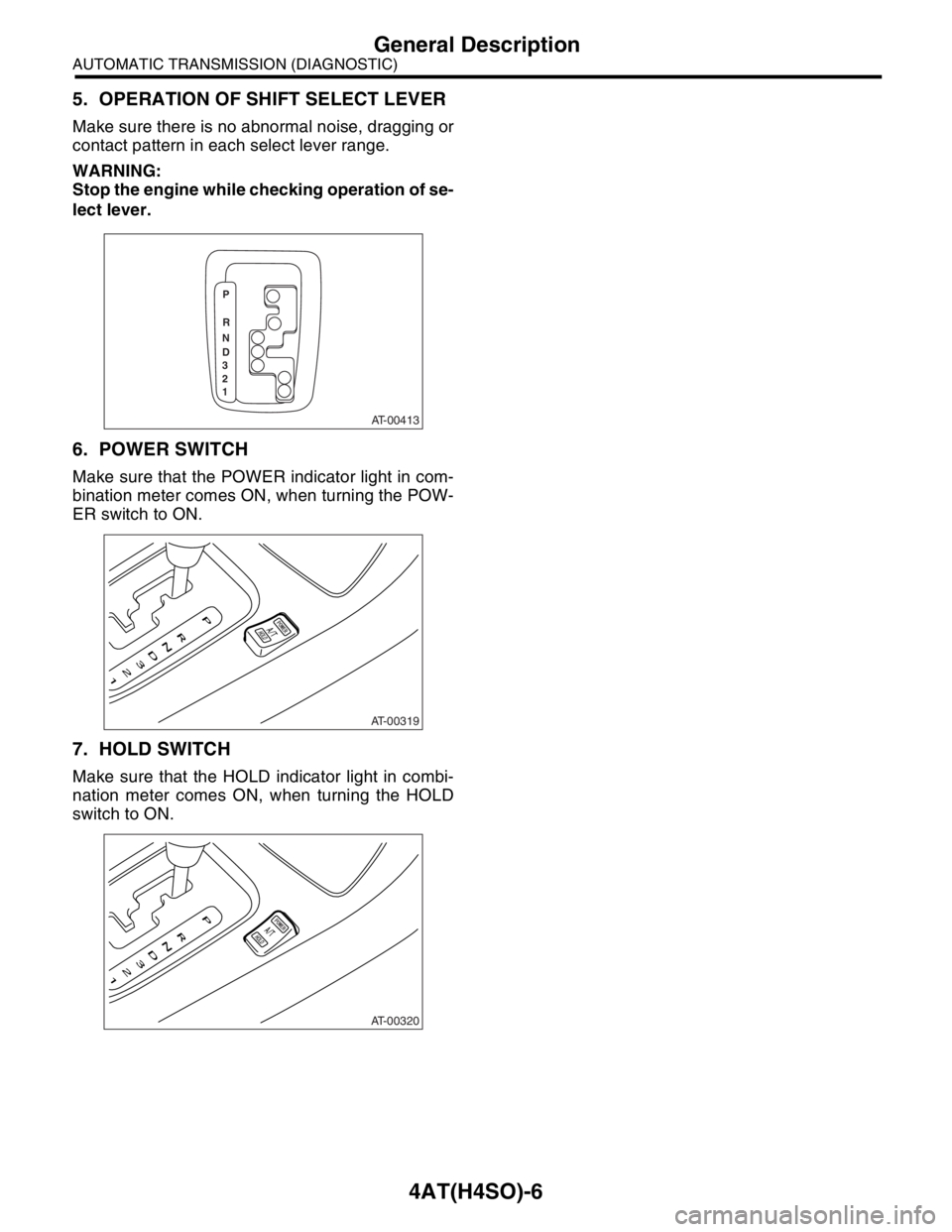2004 SUBARU FORESTER check engine light
[x] Cancel search: check engine lightPage 2204 of 2870

EN(H4DOTC 2.5)-180
ENGINE (DIAGNOSTIC)
Diagnostic Procedure with Diagnostic Trouble Code (DTC)
Step Check Yes No
1 CHECK INPUT SIGNAL FROM ECM.
1) Turn the ignition switch to ON.
2) Shift the select lever to other than “N” and
“P” ranges.
3) Measure the voltage between ECM and
chassis ground.
Connector & terminal
(B137) No. 9 (+) — Chassis ground (
−):Is the voltage 4.5 — 5.5 V? Even if the mal-
function indicator
light illuminates,
the circuit has
returned to a nor-
mal condition at
this time.Go to step 2.
2 CHECK HARNESS BETWEEN ECM AND
TRANSMISSION HARNESS CONNECTOR.
1) Turn the ignition switch to OFF.
2) Disconnect the connectors from ECM and
transmission harness connector (T3).
3) Measure the resistance of harness
between ECM connector and chassis ground.
Connector & terminal
(B137) No. 9 — Chassis ground:Is the resistance more than 1
MΩ?Go to step 3.Repair ground
short circuit in har-
ness between
ECM and trans-
mission harness
connector.
3 CHECK TRANSMISSION HARNESS CON-
NECTOR.
1) Disconnect the connector from inhibitor switch.
2) Measure the resistance of harness
between transmission harness connector and
engine ground.
Connector & terminal
(T3) No. 12 — Engine ground:Is the resistance more than 1
MΩ?Go to step 4.Repair ground
short circuit in har-
ness between
transmission har-
ness and inhibitor
switch connector.
4 CHECK INHIBITOR SWITCH.
Measure the resistance between inhibitor
switch connector the receptacle’s terminals in
selector lever except for “N” range.
Te r m i n a l s
No. 7 — No. 12:Is the resistance more than 1
MΩ?Go to step 5.Replace the inhibi-
tor switch.
Switch.>
5 CHECK SELECTOR CABLE CONNECTION.Is there any fault in selector cable
connection to inhibitor switch?Repair selector
cable connection.
Select Cable.>Contact the SUB-
ARU dealer.
N
OTE:
Inspection by DTM
is required, be-
cause probable
cause is deteriora-
tion of multiple
parts.
Page 2213 of 2870

EN(H4DOTC 2.5)-189
ENGINE (DIAGNOSTIC)
Diagnostic Procedure with Diagnostic Trouble Code (DTC)
Step Check Yes No
1 CHECK CURRENT DATA.
1) Start the engine.
2) Read the data of throttle position sensor
signal using Subaru Select Monitor or OBD-II
general scan tool.
N
OTE:
Subaru Select Monitor
For detailed operation procedure, refer to
“READ CURRENT DATA SHOWN ON DIS-
PLAY FOR ENGINE”.
OBD-II general scan tool
For detailed operation procedures, refer to the
OBD-II General Scan Tool Operation Manual.Is the voltage less than 0.1 V? Go to step 2.Even if the mal-
function indicator
light illuminates,
the circuit has
returned to a nor-
mal condition at
this time. A tempo-
rary poor contact
of the connector
may be the cause.
N
OTE:
In this case repair
the following:
Poor contact in
throttle position
sensor connector
Poor contact in
ECM connector.
Poor contact in
coupling connector
2 CHECK INPUT SIGNAL FROM ECM.
Measure the voltage between ECM connector
and chassis ground while tumble generator
valve is fully closed.
Connector & terminal
(B136) No. 16 (+) — Chassis ground (
−):Is the voltage more than 4.5 V? Go to step 4.Go to step 3.
3 CHECK INPUT SIGNAL FROM ECM.
Measure the voltage between ECM connector
and chassis ground.
Connector & terminal
(B136) No. 16 (+) — Chassis ground (
−):Does the voltage change by
shaking the harness and con-
nector of ECM while monitoring
the value with voltage meter?Repair the poor
contact in ECM
connector.Contact the SUB-
ARU dealer.
N
OTE:
Inspection by DTM
is required, because
probable cause is
deterioration of mul-
tiple parts.
4 CHECK INPUT SIGNAL FROM ECM.
Measure the voltage between ECM connector
and chassis ground.
Connector & terminal
(B136) No. 26 (+) — Chassis ground (
−):Is the voltage less than 0.1 V? Go to step 6.Go to step 5.
5 CHECK INPUT SIGNAL FOR ECM WITH
SUBARU SELECT MONITOR.
Measure the voltage between ECM connector
and chassis ground.Does the voltage change by
shaking the harness and con-
nector of ECM while monitoring
the value with Subaru Select
Monitor?Repair the poor
contact in ECM
connector.Go to step 6.
Page 2216 of 2870

EN(H4DOTC 2.5)-192
ENGINE (DIAGNOSTIC)
Diagnostic Procedure with Diagnostic Trouble Code (DTC)
Step Check Yes No
1 CHECK CURRENT DATA.
1) Start the engine.
2) Read the data of throttle position sensor
signal using Subaru Select Monitor or OBD-II
general scan tool.
N
OTE:
Subaru Select Monitor
For detailed operation procedure, refer to
“READ CURRENT DATA SHOWN ON DIS-
PLAY FOR ENGINE”.
OBD-II general scan tool
For detailed operation procedures, refer to the
OBD-II General Scan Tool Operation Manual.Is the voltage more than 4.9 V? Go to step 2.Even if the mal-
function indicator
light illuminates,
the circuit has
returned to a nor-
mal condition at
this time. A tempo-
rary poor contact
of the connector
may be the cause.
N
OTE:
In this case repair
the following:
Poor contact in
tumble generator
valve position sen-
sor connector
Poor contact in
ECM connector.
Poor contact in
coupling connector
2 CHECK HARNESS BETWEEN TUMBLE
GENERATOR VALVE POSITION SENSOR
AND ECM CONNECTOR.
1) Turn the ignition switch to OFF.
2) Disconnect the connectors from throttle
position sensor.
3) Measure the resistance of harness
between throttle position sensor connector and
engine ground.
Connector & terminal
(E50) No. 2 — Engine ground:Is the resistance less than 5
Ω?Go to step 3.Repair the harness
and connector.
N
OTE:
In this case repair
the following:
Open circuit in
harness between
tumble generator
valve position sen-
sor and ECM con-
nector
Poor contact in
coupling connector
Poor contact in
joint connector
3 CHECK HARNESS BETWEEN THROTTLE
POSITION SENSOR AND ECM CONNEC-
TOR.
1) Turn the ignition switch to ON.
2) Measure the voltage between throttle posi-
tion sensor connector and engine ground.
Connector & terminal
(E50) No. 3 (+) — Engine ground (
−):Is the voltage more than 4.9 V? Repair battery
short circuit in har-
ness between tum-
ble generator valve
position sensor
and ECM connec-
tor. After repair,
replace the ECM.
41, Engine Con-
trol Module
(ECM).>Replace the tum-
ble generator valve
assembly.
33, Tumble Gener-
ator Valve Assem-
bly.>
Page 2218 of 2870

EN(H4DOTC 2.5)-194
ENGINE (DIAGNOSTIC)
Diagnostic Procedure with Diagnostic Trouble Code (DTC)
Step Check Yes No
1 CHECK CURRENT DATA.
1) Start the engine.
2) Read the data of tumble generator valve
position sensor signal using Subaru Select
Monitor or OBD-II general scan tool.
N
OTE:
Subaru Select Monitor
For detailed operation procedure, refer to
“READ CURRENT DATA SHOWN ON DIS-
PLAY FOR ENGINE”.
OBD-II general scan tool
For detailed operation procedures, refer to the
OBD-II General Scan Tool Operation Manual.Is the voltage less than 0.1 V? Go to step 2.Even if the mal-
function indicator
light illuminates,
the circuit has
returned to a nor-
mal condition at
this time. A tempo-
rary poor contact
of the connector
may be the cause.
N
OTE:
In this case repair
the following:
Poor contact in
tumble generator
valve position sen-
sor connector
Poor contact in
ECM connector.
Poor contact in
coupling connector
2 CHECK INPUT SIGNAL FROM ECM.
Measure the voltage between ECM connector
and chassis ground while throttle valve is fully
closed.
Connector & terminal
(B136) No. 16 (+) — Chassis ground (
−):Is the voltage more than 4.5 V? Go to step 4.Go to step 3.
3 CHECK INPUT SIGNAL FROM ECM.
Measure the voltage between ECM connector
and chassis ground.
Connector & terminal
(B136) No. 16 (+) — Chassis ground (
−):Does the voltage change by
shaking the harness and con-
nector of ECM while monitoring
the value with voltage meter?Repair the poor
contact in ECM
connector.Contact the SUB-
ARU dealer.
N
OTE:
Inspection by DTM
is required, because
probable cause is
deterioration of mul-
tiple parts.
4 CHECK INPUT SIGNAL FROM ECM.
Measure the voltage between ECM connector
and chassis ground.
Connector & terminal
(B136) No. 27 (+) — Chassis ground (
−):Is the voltage less than 0.1 V? Go to step 6.Go to step 5.
5 CHECK INPUT SIGNAL FOR ECM WITH
SUBARU SELECT MONITOR.
Measure the voltage between ECM connector
and chassis ground.Does the voltage change by
shaking the harness and con-
nector of ECM while monitoring
the value with Subaru Select
Monitor?Repair the poor
contact in ECM
connector.Go to step 6.
Page 2221 of 2870

EN(H4DOTC 2.5)-197
ENGINE (DIAGNOSTIC)
Diagnostic Procedure with Diagnostic Trouble Code (DTC)
Step Check Yes No
1 CHECK CURRENT DATA.
1) Start the engine.
2) Read the data of tumble generator valve
position sensor signal using Subaru Select
Monitor or OBD-II general scan tool.
N
OTE:
Subaru Select Monitor
For detailed operation procedure, refer to “READ
CURRENT DATA SHOWN ON DISPLAY FOR
ENGINE”.
OBD-II general scan tool
For detailed operation procedures, refer to the
OBD-II General Scan Tool Operation Manual.Is the voltage more than 4.9 V? Go to step 2.Even if the mal-
function indicator
light illuminates,
the circuit has
returned to a nor-
mal condition at
this time. A tempo-
rary poor contact
of the connector
may be the cause.
N
OTE:
In this case repair
the following:
Poor contact in
tumble generator
valve position sen-
sor connector
Poor contact in
ECM connector.
Poor contact in
coupling connector
2 CHECK HARNESS BETWEEN TUMBLE
GENERATOR VALVE POSITION SENSOR
AND ECM CONNECTOR.
1) Turn the ignition switch to OFF.
2) Disconnect the connectors from throttle
position sensor.
3) Measure the resistance of harness
between tumble generator valve position sen-
sor connector and engine ground.
Connector & terminal
(E54) No. 2 — Engine ground:Is the resistance less than 5
Ω?Go to step 3.Repair the harness
and connector.
N
OTE:
In this case repair
the following:
Open circuit in
harness between
tumble generator
valve position sen-
sor and ECM con-
nector
Poor contact in
coupling connector
Poor contact in
joint connector
3 CHECK HARNESS BETWEEN TUMBLE
GENERATOR VALVE POSITION SENSOR
AND ECM CONNECTOR.
1) Turn the ignition switch to ON.
2) Measure the voltage between throttle posi-
tion sensor connector and engine ground.
Connector & terminal
(E54) No. 3 (+) — Engine ground (
−):Is the voltage more than 4.9 V? Repair battery
short circuit in har-
ness between tum-
ble generator valve
position sensor
and ECM connec-
tor. After repair,
replace the ECM.
41, Engine Con-
trol Module
(ECM).>Replace the tum-
ble generator valve
assembly.
33, Tumble Gener-
ator Valve Assem-
bly.>
Page 2344 of 2870

4AT-32
AUTOMATIC TRANSMISSION
Road Test
4. Road Test
A: INSPECTION
1. GENERAL PRECAUTION
Road tests should be conducted to properly diag-
nose the condition of the automatic transmission.
NOTE:
When performing the test, do not exceed posted
speed limit.
2. D RANGE SHIFT FUNCTION
Check shifting between 1st ←→ 2nd ←→ 3rd ←→
4th while driving on normal city streets.
3. D RANGE SHIFT SHOCK
Check the shock level when shifting up during nor-
mal driving.
4. KICK-DOWN FUNCTION
Check kick-down for each gear. Also check the
kick-down shock level.
5. ENGINE BRAKE OPERATION
Check the 3rd gear engine brake when shifting
down from D ←→ 3rd range while driving in 4th
gear of D range [50 — 60 km/h (31 — 37 MPH)].
Check the 2nd gear engine brake when shifting
between 3rd ←→ 2nd range while driving in the 3rd
range of 3rd gear [40 — 50 km/h (25 — 31 MPH)].
Check the 1st gear engine brake when shifting
between 2nd ←→ 1st range while driving in the 2nd
range of 2nd gear [20 — 30 km/h (12 — 19 MPH)].
6. LOCK-UP FUNCTION
Check that rpm does not change sharply when
the axle pedal is lightly depressed when driving on
flat roads at 60 km/h (37 MPH).
Check slip lock-up with following procedure.
Subaru Select Monitor is needed for checking (EC,
EK model).
Before start checking, check that the DTC is not ex-
isted using Subaru Select Monitor. When the DTC
is existed, perform the collective action with DTC
and check that the DTC is not existed again, and
then start the checking.
1) The check performed on flat and straight road or
free roller.
NOTE:
Slip lock-up does not operate when the vehicle is
lifted up, because of not occurring surface resis-
tance.
Also checking on the free roller, check with de-
pressing foot brake lightly to make the checking
easier, because the surface resistance will be defi-
cient2) Connect the Subaru Select Monitor.
3) Check ATF temperature using Subaru Select
Monitor.
NOTE:
ATF temperature is between 50 — 100°C (122
— 212°F).
When the temperature is low, warm-up the ATF
by running the vehicle or etc.
4) Start the engine, and make the lock-up duty be
able to read on data display of Subaru Select Mon-
itor.
5) 35 — 40 Drive the vehicle at a constant speed of
35 — 40 km/h (22 — 25 MPH).
6) Read the lock-up duty while vehicle is running.
Standard value:
25 — 45%
NOTE:
On the free roller, the value sometimes lowers.
Slip lock-up control is not operating when the
lock-up duty is less than 5%, or when the lock-up
duty goes down immediately after starts rise. On
these cases, improper ATF or deterioration of ATF
may be the cause. Check the amount of ATF or re-
place them, and then recheck it.
7. P RANGE OPERATION
Stop the vehicle on an uphill grade of 5% or more
and shift to “P” range. Check that the vehicle does
not move when the parking brake is released.
8. NOISE AND VIBRATION
Check for unusual sounds and vibration while driv-
ing and during shifting.
9. CLIMBING CONTROL FUNCTION
Check that the gear remains in 3rd when going
up a grade.
Check that the gear remains in 3rd when apply-
ing the brakes while going down a grade.
10.TRANSFER CLUTCH
Check tight corner braking when the vehicle started
with steering fully turned.
11.OIL LEAKS
After the driving test, inspect for oil leaks.
Page 2383 of 2870

4AT-70
AUTOMATIC TRANSMISSION
Air Bleeding of Control Valve
18.Air Bleeding of Control Valve
A: PROCEDURE
1) Lift-up the vehicle with shifting the select lever to
“P” range and applying the parking brake.
2) Connect the Subaru Select Monitor to the vehi-
cle.
3) Make sure there is no trouble code using Subaru
Select Monitor.
4) Using Subaru Select Monitor, check that the
ATF temperature is in less than 60°C (140°F).
5) Power OFF the Subaru Select Monitor.
6) Turn the ignition switch to “OFF”.
7) Shift the select lever to “R” range.
8) Depress the brake pedal fully until the air bleed-
ing is completed.
9) Turn the ignition switch to ON.
10) Shift the select lever to “P” range, and then wait
for more than 3 seconds.
11) Shift the select lever to “R” range, and then wait
for more than 3 seconds.
12) Shift the select lever to “N” range, and then wait
for more than 3 seconds.
13) Shift the select lever to “D” range, and then wait
for more than 3 seconds.
14) Shift the select lever to “N” range, and then wait
for more than 3 seconds.
15) Slightly depress the accelerator pedal fully.
16) Slightly release the accelerator pedal fully.
17) Start the engine.
18) Shift the select lever to “D” range.
19) Turn the Subaru Select Monitor switch to ON.
20) Select {Each System Check} in «Main Menu»
of Subaru Select Monitor.
21) On the «System Selection Menu» display
screen, select the “Transmission”. Air bleeding of
control valve starts on transmission. At this time,
the POWER indicator light in combination meter
blinks at 2 Hz. When the POWER indicator light
does not blink, repeat the procedures from step 4).
22) Air bleeding of control valve is finished when
blinking of POWER indicator light in combination
meter changes from 2 Hz to 0.5 Hz.
NOTE:
When blinking of POWER indicator light changes
from 2 Hz to 4 Hz during air bleeding, repeat the
procedure from step 4).
23) Shift the select lever to “N” range, and then turn
the ignition switch to OFF.
24) Shift the select lever to the “P” range, and then
finish the air bleeding.
Page 2465 of 2870

4AT(H4SO)-6
AUTOMATIC TRANSMISSION (DIAGNOSTIC)
General Description
5. OPERATION OF SHIFT SELECT LEVER
Make sure there is no abnormal noise, dragging or
contact pattern in each select lever range.
WARNING:
Stop the engine while checking operation of se-
lect lever.
6. POWER SWITCH
Make sure that the POWER indicator light in com-
bination meter comes ON, when turning the POW-
ER switch to ON.
7. HOLD SWITCH
Make sure that the HOLD indicator light in combi-
nation meter comes ON, when turning the HOLD
switch to ON.
AT-00413
P
R
N
D
3
2
1
AT-00319
AT-00320